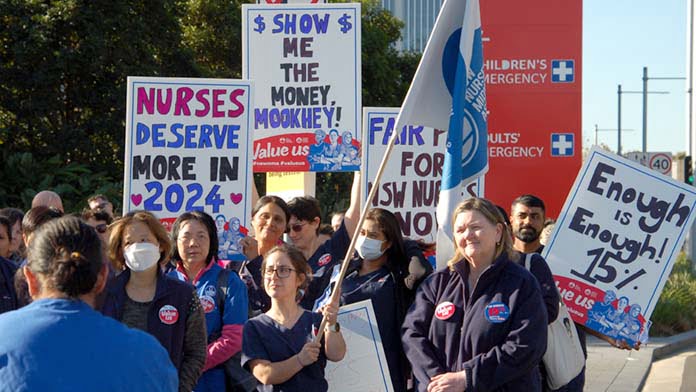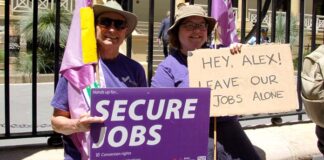Thousands of nurses and midwives across NSW held protests outside hospitals in late July as part of their campaign for an immediate 15 per cent pay rise.
About 100 members of the NSW Nurses and Midwives Association (NSWNMA) were out on their lunch breaks and end of shifts at Westmead and Royal Prince Alfred (RPA) hospitals.
Their message couldn’t be clearer. Dave, a nurses’ union delegate at Westmead Hospital, told the crowd, “NSW nurses are the second lowest paid in the country. NSW also has the highest cost of living in the country.”
Wages for a full-time nurse on average are 8 per cent below those in Queensland and Victoria.
“What does this mean? That NSW Health lost last year 13 per cent of all of its nursing staff. It means there’s not enough staff to maintain the public healthcare requirements of NSW.
“A 15 per cent pay rise will give NSW nurses a reason to stay.”
Healthcare workers were hailed “heroes” by both sides of politics for their essential work in saving lives during the COVID-19 pandemic. This has been mere lip-service, with nurses suffering for more than a decade because of the public sector wage cap.
Last year the Minns Labor government increased pay by 4 per cent after a pay freeze during COVID and several years of below-inflation pay rises.
The Minns government’s paltry pay offer of 10.5 per cent per over three years is no incentive to stay in the profession, nor are the unmet nurse-to-patient ratios on the wards.
This offer does little to claw back at years of suppressed wages. NSWNMA president O’Bray Smith addressed the crowd at RPA Hospital, saying,“Our wages today should be at a 2024 rate—they’re not. They’re at a 2010 rate.
“Third year nurses and midwives, on average, your base wage is about $77,000 a year. Would it shock you to know that firies earn about $90,000 a year and bus and train drivers $120,000 a year in comparison?
“It is shocking. So it is no wonder that nurses are leaving to work in interstate hospitals or are changing careers to survive the exploding cost of living.”
Louise, a midwife at RPA Hospital, told Solidarity, “I think one of the biggest things is that you’re going to lose staff, but birthing people and babies are going to suffer at the hands of the government.
“They think that we will just keep doing our job, but it is disrespectful and it’s just completely unfair.”
Another midwife, ex-NHS nurse Alice, warned Solidarity of this crisis facing the health system at the hands of government inaction, saying, “I feel like I’m in the NHS 10-15 years ago before shit hit the fan.
“So in the UK, for every 30 midwives they train they lose 29, and they’re losing the people that have been qualified for more than two or three years.
“That’s exactly what is starting to happen here, and the reason they are losing them over there is because we’ve had a real wage cut, just like here over the past 12 years, or when you’re on postnatal when you’ve got [to look after] 9-10 women. People don’t want to work that way, so they leave the profession.”
10 per cent won’t pay the rent
To address this, the Minns government needs to pay nurses and midwives a competitive wage that keeps up with cost of living. The one-year 15 per cent pay claim proposed by the NSWNMA also includes a 30 per cent penalty rate for night shifts, increasing sick days to 20 and funding to meet nurse-to-patient ratios.
“If it comes to it, obviously we are willing to strike,” Louisa said. “We’re not asking for something unreasonable, we’re asking for what is fair. We’re asking for you to respect us and respect our profession, nurses and midwives deserve better and deserve more.”
The nurses and midwives can win. Recently, NSW Ambulance workers were able to secure a 25 per cent pay rise over four years.
But winning will take a campaign of concerted industrial action. The union should set a date for a major strike now, with enough lead time to mobilise big numbers.
Discontent among nurses is widespread. Rank-and-file nurses won the NSWNMA to fighting for a 15 per cent pay rise, miles ahead of what the Minns government is willing to offer.
A plan for escalating, disruptive strike action will show the government nurses are serious and can deliver the desperately needed wage rise.
By Paul Kaletsis






